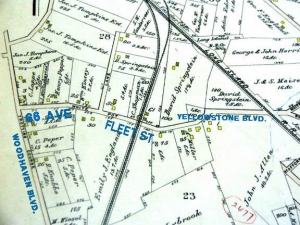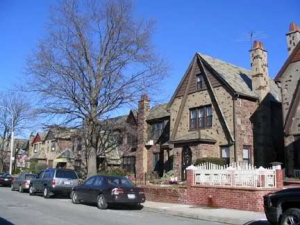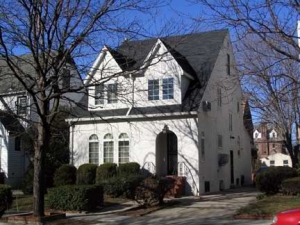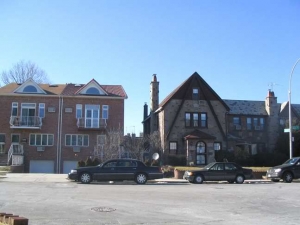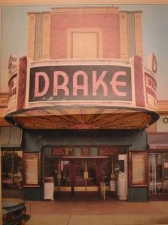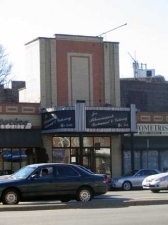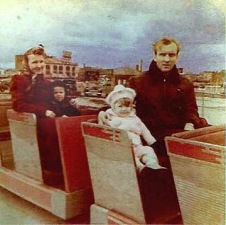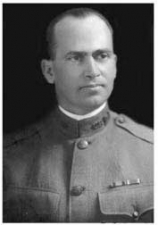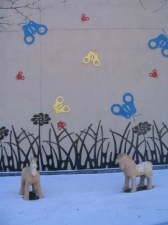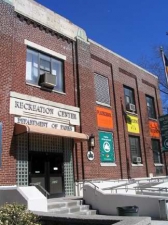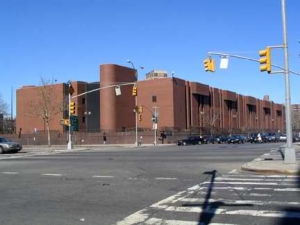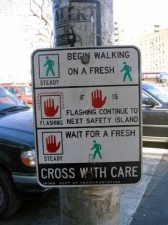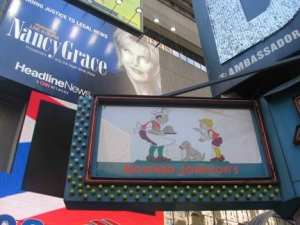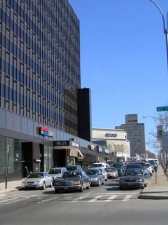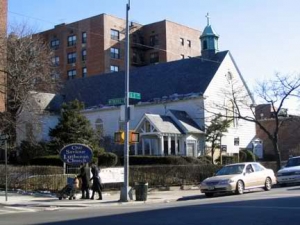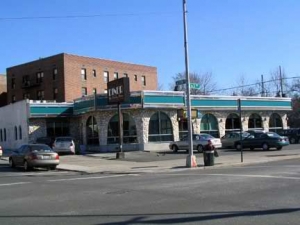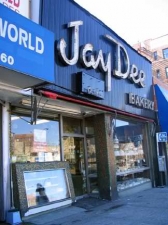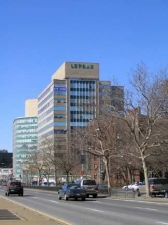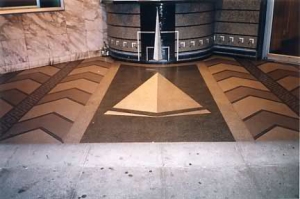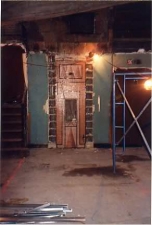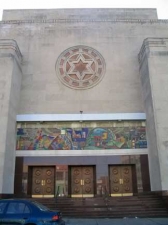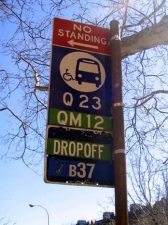The Hempstead Swamp once occupied a vast area of land that sits just east of present-day St. John’s Cemetery in Queens. The greater area was first settled in 1653 as ‘Whitepot’ by English and Dutch farmers, including the Remsen, Furman, Springsteen and Morrell families. They found the land good for growing hay, straw, rye, corn, oats and various vegetables. During colonial times, there were only a few roads that cut through the marsh. One of these was Whitepot Road, known as Yellowstone Boulevard today.
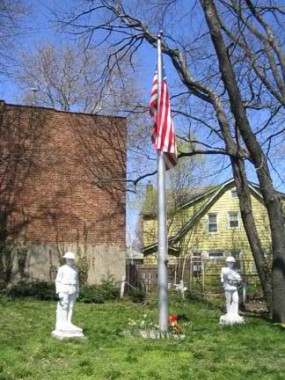 The other was Remsen’s Lane, a road which became 63rd Drive and 64th Road. The Remsen family lived along the road, and their burial ground, which includes the resting place of Revolutionary War veteran Colonel Jacobus Remsen, is still intact (left) along Alderton Street near Metropolitan Avenue.
The other was Remsen’s Lane, a road which became 63rd Drive and 64th Road. The Remsen family lived along the road, and their burial ground, which includes the resting place of Revolutionary War veteran Colonel Jacobus Remsen, is still intact (left) along Alderton Street near Metropolitan Avenue.
Near the cemetery stood a school called the Whitepot School, built by the founding families, which served the area into the early 19th century.
‘Whitepot’ was part of the Township of Newtown. A legend says that it was called Whitepot because it was purchased from the Indians for the cost of three white pots, but its actual original Dutch name was ‘Whiteput,’ which means “hollow creek.” When the English took it over, the name was Anglicized.
In the 1800’s, Trotting Course Lane was cut along the western edge of Whitepot. It was straightened, widened, and renamed Woodhaven Boulevard in the 1930s. A couple of pieces of the original road have survived to this day, one of these being a short path that runs along the western edge of the Remsen Cemetery.
By the close of the 19th century, the colonial farm families had been replaced by Chinese farmers, who leased the land on which they grew their own crops to sell at the markets of Chinatown.
Your webmaster:
Let’s take a trip back to the beginning of the 20th Century in our patented H.G. Wells model Time Machine. Setting the controls to 1909, we exit the machine when it stops and carefully unscrew the levers, lest they be stolen, forever stranding us in the past. Entering the nearest library, we consult a Belcher-Hyde atlas of the Newtown area …
…and we quickly discover that Rego Park does not yet exist. This is the eastern edge of Newtown and there’s not much here except farms and fields. Even though the Long Island Rail Road main line and its tributary, the Rockaway Branch, are here (and have been for over 40 years) only a couple of roads have been cut through.
The main roads through at the time were Whitepot Road (its meaning has been discussed above), Trotting Course Lane, now Woodhaven Boulevard, Remsen’s Lane (seen at the NW edge of the map) and Hoffman Boulevard (to the north of the LIRR); it is now Queens Blvd. Compare 1909 to the present-day map…
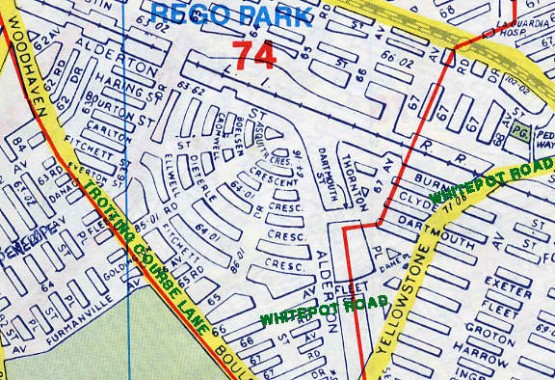 Arriving back in 2006, we see that Whitepot Road is gone, although its path can be traced along four streets: Yellowstone Boulevard (named by an early-20th century realtor; its derivation is unclear); Dane Place; Fleet Street; and 66th Avenue. 1998 map by Hagstrom
Arriving back in 2006, we see that Whitepot Road is gone, although its path can be traced along four streets: Yellowstone Boulevard (named by an early-20th century realtor; its derivation is unclear); Dane Place; Fleet Street; and 66th Avenue. 1998 map by Hagstrom
Back to Christina:
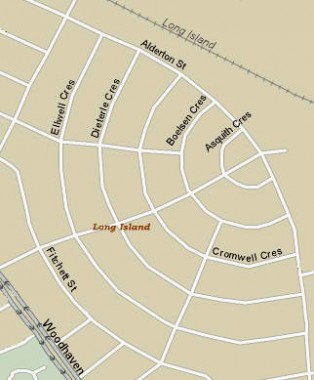 In the 1920s, the Real Good Construction Company bought up the land and carved out a grid of crescent shaped streets. Along these they built more than 500 Tudor-style one-family attached and detached homes. In 1923, Rego Park was named as such by its developers; Rego being simply the contraction of “Real” and “Good.”
In the 1920s, the Real Good Construction Company bought up the land and carved out a grid of crescent shaped streets. Along these they built more than 500 Tudor-style one-family attached and detached homes. In 1923, Rego Park was named as such by its developers; Rego being simply the contraction of “Real” and “Good.”
The semi-circular streets were laid out and given aristocratic-sounding alphabetized names from A through F: Asquith, Boelsen, Cromwell, Dieterle, Elwell and Fitchett. The layout is nicely displayed on this Mapquest map.
The Rego Park of today fills a triangular piece of land bordered by three major Boulevards: Queens, Woodhaven and Yellowstone. All three are major commercial strips as well as homes to large apartment complexes.
Two lines of the LIRR, the Main Line and the Rockaway Branch, border the Crescents, and prevented them from being completed as circles. The Main Line, of course, is still fully functional, but the part of the Rockaway Branch through Rego Park became defunct in 1962. (The part south of Liberty Avenue, starting at Rockaway Boulevard, remains active as part of the A subway line.) Take a tour of the line, including the Whitepot Underjump, on FNY’s Rockaway Branch page, and at Jeff Saltzman’s Dead Tracks. The Regional Rail Working Group is looking toward reactivating the northern portion of the line to improve rail service between Queens and the Rockaways.
[Good luck with that!–your webmaster]
Original English-style attached homes line the quaint, tree-lined streets of Rego Park in a tasteful way.
The design of the planned community allowed for detached homes as well.
Unfortunately, Fedders housing has also managed to creep in.
The photo is starkly illustrative of the contrasting ideals of the developers of the 1920s and the ones polluting NYC streetscapes today. The Tudor shown on the right has tasteful, engaging touches designed to catch the admiring eye of not only the people who live in this house, but also visitors, vendors and businesspeople who are passing through. The house on the left was built from a template. The grassy lawn of the Tudor has been replaced by concrete ramps leading to basement garages. Air conditioning units, water meters, and cheap metal balconies that rust almost from their installation highlight the exterior instead of the life-affirming touches that marked our architecture in previous decades. –your webmaster
Now let’s take a stroll along Rego Park’s perimeter, starting on Woodhaven Boulevard…
The Drake Theater opened in 1935 and closed in the 1990s. Above are 1986 and 2006 shots of the exterior. The facade of the Drake was used for a scene in the 1997 Howard Stern biopic, Private Parts. Soon after, Joe Abbracciamento Restaurant, which opened next door in 1948, took over the Drake to use for catered functions. Abbracciamento also operated a restaurant on Canarsie Pier during the 80s and 90s which has since closed. 1986 photo from Warren Harris at Cinema Treasures.
Your webmaster interrupts again:
One anecdote from Cinematreasures is illuminating:
In December, 1978, the Drake’s interior was heavily damaged during a midnight screening of a Led Zeppelin concert movie. According to newspaper reports, the near-capacity crowd of 500 (mostly teenagers) started complaining about the sound system by throwing beer and liquor bottles at the screen and tearing holes in it. Some took fire extinguishers from the walls and used them to smash whole rows of seats and the theatre’s candy counter. As they exited, they broke all the glass in the entrance doors. Police blamed the behavior on alcohol and drugs smuggled into the theatre. One person was arrested for beating up an usher.
Ah, those were the days. People complaining about this kind of thing at hip hop events should know it’s nothing new. Knuckleheads plus drugs and alcohol always means trouble! (Of course there are more guns involved these days.)
Christina resumes…
At Woodhaven and Queens Blvds. you’ll find Queens Center. Opened in 1972, its major tenants over the years have included Ohrbach’s, JC Penney, Macy’s and Sterns. In 2005, it underwent a major expansion and renovation. Above photo from Macerich Company. A nice touch was added to the mall’s new design: the names of almost every Queens neighborhood circle its facade.
Prior to hosting the mall, this spot was home to an amusement park called Fairyland.
Above: [Christina’s] Mom and Grandpa enjoy a ride with Cousin Bobby and Aunt Mary in 1951. The Elmwood Theater can be seen behind them across Queens Boulevard. Thanks to Doug LeBlang for touching up the photo.
Not a few subway riders are confused about why the IND Woodhaven Blvd. station is subtitled “Slattery Plaza”…
From West Point’s website:
“John Rodolph Slattery graduated 5th in the USMA Class of 1900. Born in Athens, OH, on 31 Jan 1877, he was appointed to the Academy by Charles P. Taft, brother of President William Howard Taft.
After graduation, Slattery was assigned to the Philippines to work on bridges and roads—a typical beginning for an engineer. The next few years found him living in Honolulu, HI; Jacksonville, FL; and Vicksburg, MS, in charge of flood control. He remained in Vicksburg for several years and worked on the Flood of 1916. He then served in France as the Chief Engineer of the Seventh Army Corps until 1919.
One of his contributions was the development of a project on the upper Hudson River known as the Port of Albany. After it was completed, oceangoing vessels could travel 150 miles inland from New York City. While working on the project, Slattery was noticed by John Delaney, Dock Commissioner of New York City, who was impressed with Slattery’s work and wanted him to serve as one of Delaney’s chief aids on the new system of transportation in New York, the subway system. In an unusual move, the Army granted Slattery a year’s leave of absence so he could work on the subway system. At the end of that year, Slattery had served 25 years and wanted to retire, but the Secretary of War would not allow it. Dissatisfied with the decision, Slattery resigned in 1925 and became the Deputy Chief Engineer of the Board of Transportation, in charge of such projects as the tunnels to Queens and Staten Island and the New York Central Railroad.
Slattery earned a master of arts from Ohio University. He was a member of the American Society of Civil Engineers and past president of the Society’s New York section, American Military Engineers and the Municipal Engineers. He also received accolades from the mayor of New York for his work. The intersection of Queens and Woodhaven Boulevards in Queens, NY, is named Slattery Plaza in his honor.
He suffered a heart attack while working in 1932 and died several days later in Jackson Heights, NY, at the age of 55.”
We are technically just in Elmhurst, albeit right on its border with Rego Park. So let’s move east, into official territory…
And we soon come upon Lost Battalion Hall (Queens Blvd. south of the Horace Harding Expressway). This community center is special because it was named after a WWI army unit which suffered so many casualties that it was considered to be “lost.” Originally built as a VFW and American Legion hall in 1939, the Parks Department took it over in 1960 and since then has run it as a neighborhood recreation center. The VFW has stayed on the premises and is located in an upstairs office, which is rent-free, but the American Legion moved out in 1962.
Behind the Hall is a whimsically decorated play area which sees a lot of use when there isn’t snow on the ground. A spray fountain, hopscotch boards and game tables are available for use during warmer months.
The City of New York’s Department of Environmental Protection also maintains a water pumping station at the site.
 From 1988-1992, a popular sitcom, Dear John, starring Judd Hirsch, was a part of NBC’s lineup. In the show, the character of John, played by Hirsch, joined a support group for divorced and widowed people that met regularly in a Rego Park community center. Former Vaudeville sexpot Billie Bird often got the best punch lines.
From 1988-1992, a popular sitcom, Dear John, starring Judd Hirsch, was a part of NBC’s lineup. In the show, the character of John, played by Hirsch, joined a support group for divorced and widowed people that met regularly in a Rego Park community center. Former Vaudeville sexpot Billie Bird often got the best punch lines.
Real life celebrities have also called Rego Park home. These include: comedians Sid Caesar and Eddie Bracken, burlesque queen Gypsy Rose Lee, actresses June Havoc and Alice Faye, former Miss America and city Cultural Affairs Commissioner Bess Myerson, TV producer Fred Silverman and former Knicks star Willis Reed.
[Your webmaster was a Dear John fan, since the women were cute, but doesn’t remember any of the plots.]
Although the paranoid among us may fear that top secret experiments are being conducted inside this suspicious-looking windowless structure, in reality it’s just a telephone building belonging to AT&T.
I know, I know. This is the Boulevard of Death. But hurried, harried New Yorkers aren’t going to take the time to read these crossing directions!
World famous for their orange-roofed building design as well as for their ice cream, Howard Johnson‘s had a location at Queens and Junction Blvds throughout most of the 20th century. Celebrity chef Jacques Pepin once worked here. Photo from Under the Orange Roof.
It was replaced by this boxy, black, glass-covered office building in 1970. [From 1985-1993, Queens was home to a different kind of HoJo.]
Your webmaster:
A look at the Simple Simon– motif’ed Howard Johnson logo, from their last NYC bastion in Times Square. It succumbed in 2004.
This was formerly a Queens branch of the department store, Alexander’s, before the retail chain folded in the 1990s. (Alexander’s, Inc. continues to operate as a real estate investment trust, however.) The lot behind it is gigantic and no longer used for parking cars, as a garage was included in the design of the new mall. Walmart planned to build one of their stores in the empty space, but as they were deemed to be a politically incorrect fit for a union town such as ours, the idea was shot down. There’s now a debate over what the lot will become – either an extension of the mall or residential space.
In the meantime, five major stores inhabit Rego Park Center, the anchor of 63rd Drive’s commercial bustle.
Sneaking down 63rd Drive before continuing along Queens Blvd, we happen upon Our Savior Lutheran Church, an institution that has been in existence for almost 80 years. Services are conducted in English and Chinese, reflecting the diversity of modern-day Rego Park.
Just down the street is the Shalimar Diner, built in 1972 after the “Rego Park Inferno” destroyed a row of stores and the Rego Park branch of the public library which was subsequently rebuilt.
The Lefrak Organization has definitely made its presence known in Rego Park and neighboring Corona. They like to display their name on top of their properties ala Queens native, Donald Trump.
The Jay Dee Bakery has been on Queens Blvd. for decades. It’s changed hands a few times, but the name and vintage neon sign has stayed put throughout it all. Your Webmaster believes the sign dates to the 1950s.
Can you spot Christina’s reflection?
End of the Trylon?
What’s been done to the poor Trylon Theater is a crying shame! They’ve destroyed the mosaics and ticket booth, gutted the interior, stripped the marquee…and for what? A true art deco gem, and a representation of New York’s first World’s Fair in 1939, it deserves better than this. The Education Center for Russian Jewry is slated to move into the space. Why they feel the need to destroy the theater’s most distinguishing features boggles the mind.
A stop work order is in effect while the Landmarks Preservation Commission considers landmarking for the property. It was nice of them to wait until after the jackhammering was underway. Photos from Michael Perlman of Save the Trylon.
Jewish people have lived in Rego Park for a long time, and there are many Holocaust survivors residing in the community. The Rego Park Jewish Center was founded in 1939. A colorful mosaic depicting Old Testament scenes and symbols lines the wall above the doorways to the sanctuary.
More recent immigrants likely come from China, Russia, Iran, India, Colombia, Korea or Romania. This diversity is reflected in store signs, such as the one above, which is in English, Chinese and Russian.
We’re in the home stretch now, heading down Yellowstone Boulevard back toward Woodhaven, originally a part of the old Whitepot Road. For much of its route, Yellowstone Boulevard is lined with large apartment complexes, as the photo left illustrates.
So the MTA thinks that the B37 stops here, eh? Well, I think not. [It runs on 3rd Avenue in Sunset Park and Bay Ridge, Brooklyn]
112th Precinct Stationhouse at Austin Street
Sources:
Jackson, Kenneth, Ed., Encyclopedia of New York City, Yale University Press, New Haven, 1995
Cinema Treasures
NYC Parks Department
New York Times
A Picture History of Kew Gardens
Queens New York
Save the Trylon
Streetlight Nuts
United States Military Academy
George Miller and the staff at Queens Library at Jamaica
More neighborhood photos are available in my Rego Park slideshow.
The photos for this page were taken on March 5, 2006, and the page was completed on March 19, 2006 by Forgotten New York correspondent, Christina Wilkinson, seen here aspiring to ultimate power at the White House.
To reach Christina: nutrichris@rcn.com
To reach the Webmaster: erpietri@earthlink.net
©2006 Midnight Fish


